The Siamese Algae-Eater, with its black stripe and up to 6 inches long, is a standout fish. It’s a bottom feeder from Southeast Asia, loved by those fighting algae in planted tanks. Known for eating algae, it’s a top choice for keeping aquariums clean.
This fish belongs to the Crossocheilus genus and is the main type in aquariums. Sometimes, other similar species like C. langei or C. atrilimes might show up. Its shape and appetite for many algae types make it great for a clean, healthy aquarium.
What is a Siamese Algae-Eater?
Origins and Scientific Classification
The Siamese Algae-Eater, also known as the True Siamese Algae-Eater, is a fish from freshwater. It is classified as Crossocheilus oblongus (formerly Crossocheilus siamensis). It comes from Southeast Asia, mainly in Thailand, Malaysia, Cambodia, Laos, and parts of Indonesia. This fish was first described in 1823 and is the main type of the Crossocheilus genus.
Identifying True Siamese Algae-Eaters
It’s crucial to know how to spot the True Siamese Algae-Eater. It looks similar to other fish like the Chinese Algae Eater (Gyrinocheilus aymonieri) and the Flying Fox (Epalzeorhynchos kalopterus). This fish has a long, thin body with a black stripe from its snout to its tail base. Its fins and tail are clear, and it has small barbels near its mouth.
| Species | Maximum Size | Ideal Tank Size | Water Parameters |
|---|---|---|---|
| Crossocheilus oblongus (Siamese Algae-Eater) | 6 inches (15 cm) | 50-55 gallons | 68-80°F (20-27°C), pH 6.0-8.0 |
| Gyrinocheilus aymonieri (Chinese Algae Eater) | 11 inches (28 cm) | 75+ gallons | 72-82°F (22-28°C), pH 6.5-7.5 |
| Epalzeorhynchos kalopterus (Flying Fox) | 6 inches (15 cm) | 30+ gallons | 72-82°F (22-28°C), pH 6.5-7.5 |
“Correctly identifying the True Siamese Algae-Eater is important, as there are several similar-looking species that are often mistaken for it.”
The Aquarium Cleaning Prowess of Siamese Algae-Eaters
The Siamese Algae-Eater is famous for its great ability to eat algae. It’s a key fish in aquariums because it eats hard-to-remove algae like black beard algae and hair algae. These fish can’t get rid of all algae, but they do a lot to keep it under control. They work best when there are enough of them for the tank size.
Controlling Stubborn Algae Types
Siamese Algae-Eaters are top algae eaters in the aquarium world. They eat a lot and can handle many types of algae. This makes them great for fighting black beard algae and hair algae, which are tough to remove.
| Algae Type | Siamese Algae-Eater Effectiveness |
|---|---|
| Black Beard Algae | Highly Effective |
| Hair Algae | Highly Effective |
| Green Spot Algae | Moderately Effective |
| Brown Diatom Algae | Moderately Effective |
The Siamese Algae-Eater’s algae eater effectiveness depends on several things. These include tank size, food availability, and fish health. It’s important to have the right number of these fish in your tank to keep algae in check.
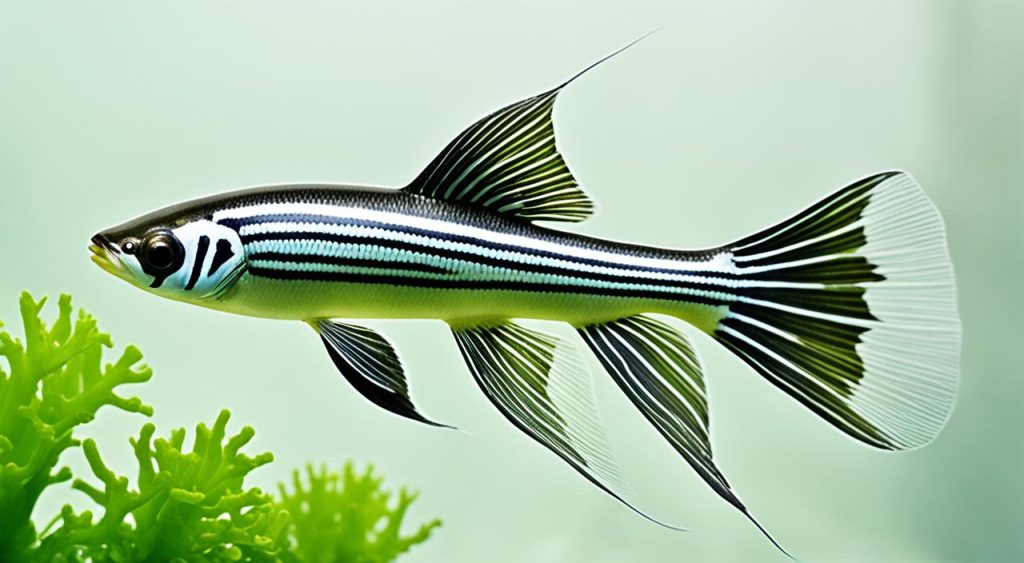
“The Siamese Algae-Eater has been an absolute game-changer in my aquarium. I was struggling with persistent black beard algae, but after adding a few of these fish, the problem has been significantly reduced. I’m thrilled with the results!”
Natural Habitat and Behavior
Siamese Algae-Eaters live in the clear, fast streams and rivers of Southeast Asia. They prefer the lower water column, where they form large groups for safety. This environment has plenty of oxygen, crucial for their well-being in captivity.
These fish are great at controlling algae, making them a favorite among aquarium owners. They can grow up to 6 inches long and live up to 10 years with proper care. They like a temperature of 75-80°F and a pH of 6.5-8.0, showing they are quite adaptable.
| Characteristic | Details |
|---|---|
| Conservation Status | Least Concern (IUCN 3.1) |
| Maximum Size | 15 cm (6 inches) |
| Lifespan | Up to 10 years |
| Ideal Temperature Range | 75 – 80°F (24 – 27°C) |
| Water Parameters | pH: 6.5 – 8.0, GH: 5 – 20, KH: 5 – 10 |
| Natural Habitat | Southeast Asia, including the Chao Phraya and Mekong Basins, and the Malay Peninsula |
| Diet & Feeding | Omnivore, primarily consuming algae, supplemented with live, freeze-dried, or frozen foods |
| Behavior | Peaceful, schooling, most active during the day |
Siamese Algae-Eaters are a top pick for aquarium fans because of their natural habits and peaceful nature. They fit well in many tank setups. Their skill in fighting algae and calm behavior makes them a great addition to community tanks.
SIAMESE ALGAE-EATER Aquarium Setup Requirements
Tank Size and Water Parameters
Siamese Algae-Eaters need a big aquarium to move around. A tank of at least 55 gallons is best for one fish. They like water that’s well-oxygenated and has a moderate to high flow, just like their home rivers.
The perfect water has a pH of 6.0-8.0, temperatures between 68-80°F, and TDS of 50-250 ppm. Keeping the water clean with regular water changes is key to their health.
Decorations and Plants
Make the aquarium feel like their natural home with a sandy bottom, river rocks, and live plants like Java fern and Anubias. Adding driftwood and other decorations gives them places to hide and eat. A strong current is important, so use a high-flow filter or a small powerhead.
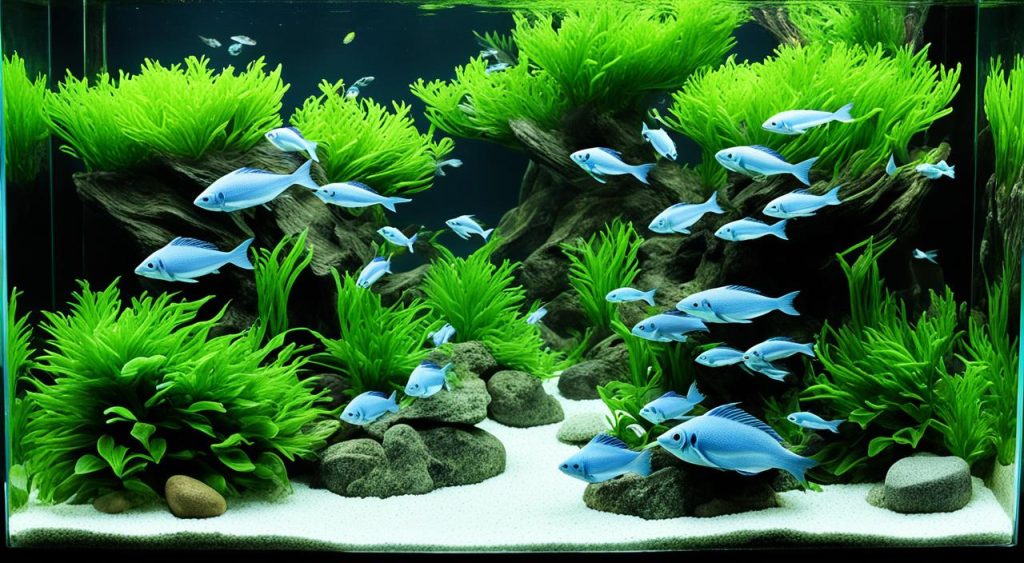
“A single Siamese algae eater can thrive in a 50- to 55-gallon freshwater aquarium, and they can tolerate water temperatures ranging from 68–80°F (20–27°C) and a pH level of 6.0–8.0.”
Keeping Siamese Algae-Eaters in Groups
Siamese Algae-Eaters do well alone, but they feel safer and less aggressive in small groups. Keeping 3-5 of them together helps prevent fights and lets them act naturally.
Adding plants and decorations helps reduce fighting within the group. These fish can grow up to 6 inches long. They need a big tank, at least 50-55 gallons, to live peacefully.
It’s important to have a large enough tank for a group of Siamese Algae-Eaters. They can be a bit aggressive with each other. A bigger tank with hiding spots can help them live together better.
| Fish Species | Maximum Length | Recommended Minimum Tank Size |
|---|---|---|
| Siamese Algae-Eater | 6 inches (15 cm) | 50-55 gallons |
| Chinese Algae Eater | 11 inches (28 cm) | 75-100 gallons |
| Flying Fox | 6 inches (15 cm) | 50-55 gallons |
Keeping Siamese Algae-Eaters in groups and giving them a good home makes them great at cleaning your tank.
Suitable Tankmates for Siamese Algae-Eaters
Choosing the right siamese algae-eater tankmates is key for a peaceful aquarium. These fish are calm and can live with many community fish. Just make sure they have enough food and aren’t too shy.
Ideal Fish Companions
Great friends for Siamese algae-eaters include barbs, danios, and some south american cichlids. Livebearers like guppies and mollies also work well. Pick fish that are about the same size and like to swim as much as the Siamese algae-eater.
Compatible Invertebrates
Siamese algae-eaters get along with big shrimp like amano shrimp and dwarf crayfish. But, don’t mix them with tiny shrimp because they might eat them. Atyopsis fan shrimp are a great choice because they like strong currents too.
| Tankmate Type | Compatibility | Examples |
|---|---|---|
| Fish | Suitable | Barbs, danios, certain south american cichlids, livebearers |
| Invertebrates | Suitable | Amano shrimp, dwarf crayfish, atyopsis fan shrimp |
| Smaller Shrimp | Not Suitable | Neocaridina shrimp |
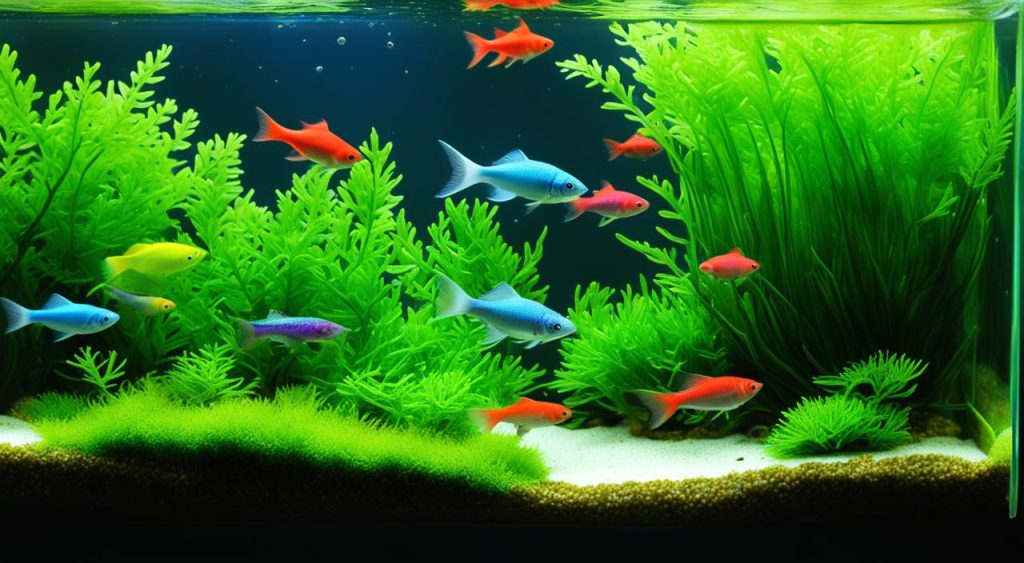
Feeding Siamese Algae-Eaters
Siamese Algae-Eaters eat both plants and animals. In the wild, they look for algae, dirt, and small bugs on the river floor. In aquariums, they like to eat algae wafers, spirulina flakes or pellets, and blanched veggies.
Supplementing Their Algae Diet
It’s key to add plant-based foods to their diet to keep them eating algae. They might choose protein-rich fish foods over algae if given the chance. A diet with both algae and extra food helps them stay healthy and good at controlling algae in the tank.
- Siamese Algae-Eaters typically grow up to 6 inches (15 cm) in length.
- Juvenile Siamese Algae-Eaters need lots of nutrients to grow and will look for algae and small food bits.
- As they get older, Siamese Algae-Eaters might not want to eat as much algae, so extra food is important.
By giving them a mix of algae foods and extra food, your Siamese Algae-Eaters will stay healthy and active. They’re important for keeping your tank clean by eating hard-to-control algae. They’re a great choice for any planted or community tank.
Breeding Siamese Algae-Eaters in Home Aquariums
Breeding Siamese algae-eaters at home is rare. Some have bred them, but it’s not common. The exact steps to breed them are not well-known to most people. Most of these fish come from the wild, not fish farms, because breeding them in captivity is hard.
Trying to breed Siamese algae-eaters at home is tough. You need to change the water, flow, and light to help them breed. Keeping the water right, with a pH of 6.5 to 6.8 and a temperature of 77°F, is key. Also, having well-oxygenated water and more algae-eaters might help them spawn.
Knowing the gender of these fish can help with breeding. Females are wider than males when viewed from above. This can help pick the right fish for breeding.
“Breeding Siamese algae-eaters in captivity is not a well-documented process, and the specific requirements for successful spawning are not widely known among aquarium hobbyists.”
Trying to breed Siamese algae-eaters at home is exciting but rare. Aquarium fans who want to try need to play with different water settings and conditions to encourage breeding. But, even with the best conditions, breeding them is still hard and not very successful compared to other fish.
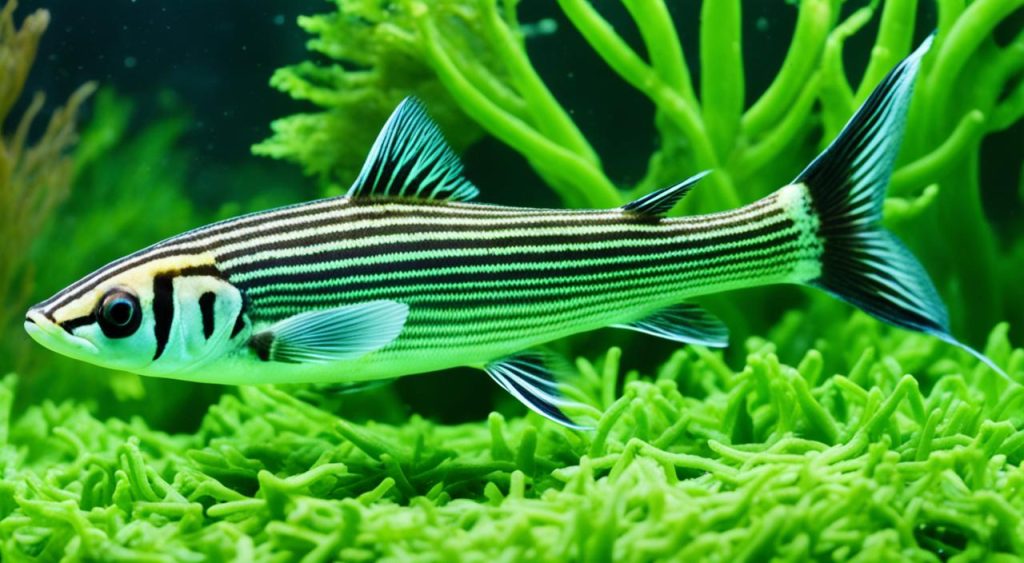
Sourcing and Identifying Siamese Algae-Eaters
Siamese Algae-Eaters, or Crossocheilus oblongus, are popular freshwater fish known for eating algae. But, finding the real Siamese Algae-Eater can be hard. They often get mixed up with fish like the Chinese Algae Eater or the Flying Fox.
It’s best to buy Siamese Algae-Eaters from trusted online stores or your local fish shop. They usually cost about $10.00 AUD each. But, prices can change depending on where you are and how easy they are to find.
It’s important to know how to tell a Siamese Algae-Eater apart from others. They can grow up to 6 inches (16 cm) long, which is bigger than some similar fish. They also have a long body and a flat head, unlike the Chinese Algae Eater.
Make sure you’re getting the Siamese Algae-Eater you want by checking the fish closely. If you don’t, you might end up with a different fish that doesn’t eat algae as well.
“Proper identification is key when purchasing Siamese Algae-Eaters to avoid getting a closely related but distinct species.”
By choosing trusted sellers and checking the fish’s identity, you can be sure you’re getting these helpful algae-eaters for your tank.
Dispelling Myths About Siamese Algae-Eaters
Siamese Algae-Eaters are often seen as a magic solution for aquarium algae. But, they’re not a full replacement for aquarium maintenance. They can’t keep a tank perfectly clean on their own. In fact, they might spread algae spores through their waste.
Also, one Siamese Algae-Eater won’t be enough for big algae problems. You might need a group to see results, which can increase the tank’s bio-load. It’s key to know their limits and not rely too much on them for siamese algae-eater myths.
| Myth | Reality |
|---|---|
| Siamese Algae-Eaters can single-handedly keep a tank algae-free. | Siamese Algae-Eaters can help control algae, but they are not a replacement for regular aquarium maintenance. |
| A single Siamese Algae-Eater is sufficient for any size aquarium. | A group of Siamese Algae-Eaters may be necessary to make a significant impact on algae control limitations. |
| Siamese Algae-Eaters don’t contribute to the spread of algae. | Siamese Algae-Eaters can actually spread algae spores through their waste, requiring careful aquarium cleanliness. |
Understanding the siamese algae-eater myths and their limits is key for a healthy aquarium. With the right care, Siamese Algae-Eaters can be great helpers. But, they shouldn’t be seen as a quick fix for all algae issues.
Distinguishing Siamese Algae-Eaters from Similar Species
It’s important to know the difference between the Siamese Algae-Eater (Crossocheilus oblongus) and other fish that look alike. This is key to picking the right fish for your tank to control algae.
The Chinese Algae Eater (Gyrinocheilus aymonieri) often gets mixed up with the Siamese Algae-Eater. But, it has a special sucker-like mouth. The Flying Fox (Epalzeorhynchos kalopterus) stands out with a bright yellow stripe on its body.
Don’t confuse it with the Garra cambodgiensis, also called the “False Siamese Algae-Eater”. It looks similar but lacks a key feature of the real Siamese Algae-Eater. This feature is a continuous black stripe that goes into the tail fin.
Knowing how to spot the Siamese Algae-Eater is key to picking the right fish for your tank. By learning the differences between these fish, you can choose wisely. This way, you’ll get the most out of the Siamese Algae-Eater’s great algae-eating skills.
Tips for Keeping Siamese Algae-Eaters Healthy
Keeping siamese algae-eaters healthy is important. It means keeping the water quality high by changing the water often and checking the pH, temperature, and dissolved solids. These fish don’t like bad water.
They need a diet rich in algae foods like wafers and blanched veggies. This helps them act naturally. Also, make sure their tank has enough room to swim, strong water flow, and places to hide.
To stop disease prevention, keep the water clean and make sure the fish have a happy home. Check the water often and change it partway to keep it safe. Also, feed them a mix of algae foods and protein-rich foods to keep their immune system strong.
By doing these things, you can help your Siamese Algae-Eaters live a long and healthy life in your tank. With the right care, they can be great at keeping your tank clean.
FAQ
What is a Siamese Algae-Eater?
The Siamese Algae-Eater is a sleek fish that eats algae. It’s a favorite among fish keepers for its skill in fighting algae in planted tanks.
Where do Siamese Algae-Eaters originate from?
They come from Southeast Asia, mainly in Thailand, Malaysia, Cambodia, Laos, and parts of Indonesia. They were first described in 1823 and are the main type of the Crossocheilus genus.
How can I identify a True Siamese Algae-Eater?
Look for a slender fish with a black stripe from its snout to its tail. It has clear fins and tail, and small barbels near its mouth.
How effective are Siamese Algae-Eaters at controlling algae?
They are known for their great algae-eating skills. They work well against tough algae like black beard and hair algae.
What is the natural habitat of Siamese Algae-Eaters?
In the wild, they live in fast-flowing streams and rivers. They prefer the lower water layer and like clear, oxygen-rich water.
What are the aquarium requirements for Siamese Algae-Eaters?
They need a big tank, at least 55 gallons for one fish. They like well-oxygenated water with moderate flow. The ideal conditions are a pH of 6.0-8.0, temperatures of 68-80°F, and total dissolved solids of 50-250 ppm.
Should Siamese Algae-Eaters be kept in groups?
They can live alone, but they prefer to be in groups. Keeping 3-5 together makes them feel safer and less aggressive.
What type of tank mates are suitable for Siamese Algae-Eaters?
They get along with many fish, as long as those fish can compete for food and aren’t too shy. Good friends include fast fish like barbs and danios, and livebearers like guppies and mollies.
What should Siamese Algae-Eaters be fed?
They eat both plants and animals. In the tank, they like algae wafers, spirulina flakes or pellets, and blanched veggies. Adding these foods helps them eat algae well.
Can Siamese Algae-Eaters be bred in home aquariums?
Breeding them at home is rare. Some people have bred them, but it’s not common. The exact breeding needs are not well-known to hobbyists.
Where can I purchase Siamese Algae-Eaters?
You can find them at local fish stores or online from trusted sellers. Make sure to check the species to ensure you get the True Siamese Algae-Eater.
Are there any myths or limitations to Siamese Algae-Eaters as algae controllers?
Some think they’re a magic solution for algae, but they’re not. They need proper tank care and can’t do it all. For big algae problems, you might need a group of them.
How can I distinguish Siamese Algae-Eaters from similar species?
Tell them apart by their sucker-like mouth and a yellow stripe on the True Siamese Algae-Eater. The Flying Fox has a different stripe. The Garra cambodgiensis looks similar and is called the “False Siamese Algae-Eater.”
How can I ensure the health and longevity of Siamese Algae-Eaters?
Keep them healthy by changing the water often, checking water quality, and feeding them well. They need a big tank with strong flow and places to hide.
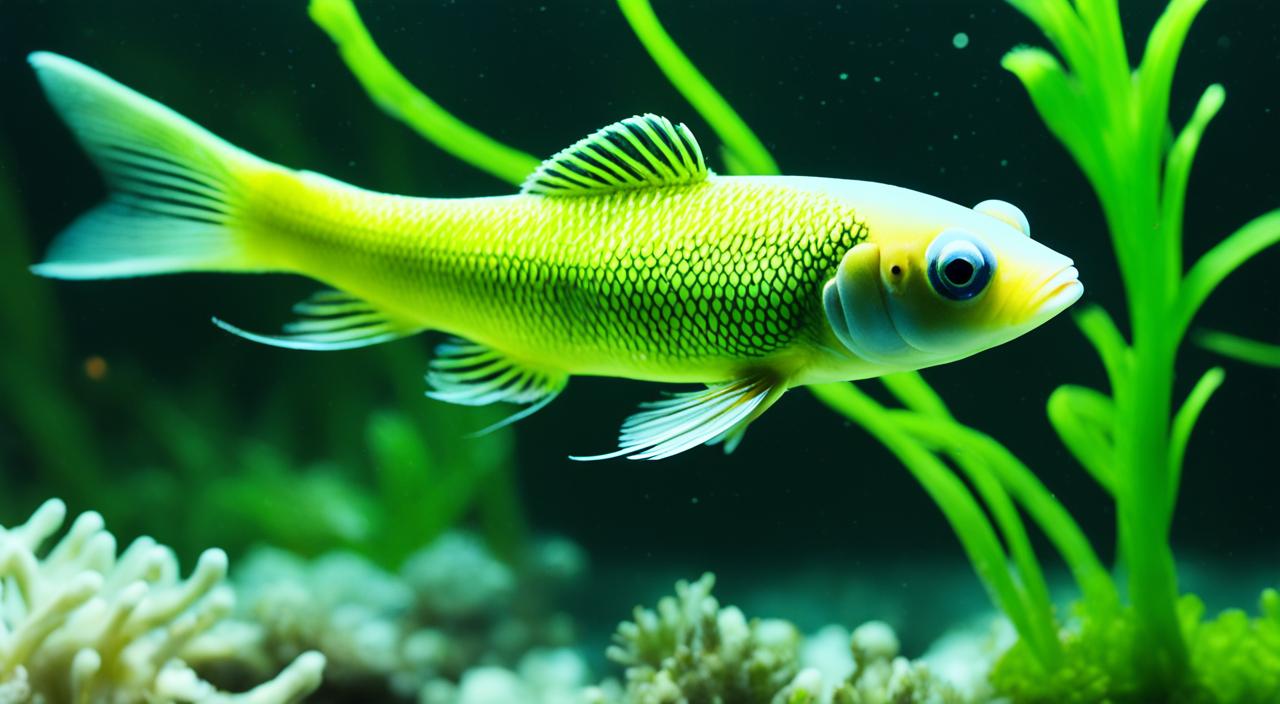

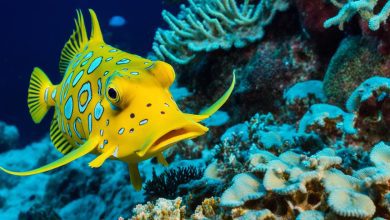


One Comment